The (Complete) Last Log of 'Shady Lady'
From Aborigines to Zeros, navigator John Nash ’39 logged an unforgettable World War II bombing mission
For navigator John Nash ’39 and his Shady Lady crew, an August 1943 bombing run from northern Australia to Japanese-occupied Borneo evolved into something of a four-day walkabout. They dodged thunderstorms and Japanese Zero fighters, crash-landed in an Australian salt pan en route home, and were guided from the bush by a Benedictine monk.
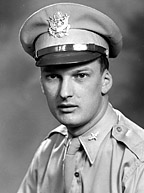
John Nash '39 was the navigator on Shady Lady's last flight.
A B-24D Liberator bomber, Shady Lady took off from near Darwin, on Australia’s north coast, late in the afternoon of Aug. 13. The 12-plane squadron was to bomb oil refineries at Balikpapan, Borneo — a 2,700-mile round trip that at the time was the longest attempted in any theater of World War II. Here is Nash’s complete mission log; at bottom are military photos from salvage operations on Shady Lady that allowed the bomber to fly from the bush.
Aug. 13, 1943 (Friday)
- 0800: Left Fenton as part of 12-plane squadron for Darwin to gas up for longest strike mission yet pulled in any theater of war. Target: Balikpapan, Borneo, round trip 2,300 nautical miles.
- 0900: Landed at Darwin, North Australia. Col. Miller’s ship had to return to Fenton. Lt. Roth in Beautiful Betsy smashes tail skid on landing, out for trip.
- 1000-1200: Assigned rooms in shell-torn Darwin barracks. Pilots and bombardiers briefed.
- 1200: Have dinner in bullet-ridden mess hall.
- 1300-1700: Take cat-naps in barracks, then get lunch at mess hall. Leave for line.
- 1740: Rev up engines, taxi to the strip, then just barely skim trees as we take off. Very heavy load.
- 2000+: Pass over Timor just after dusk. Guns test fire OK. Weather good so far.
- 2130+: Pass over Tijger Islands (mostly shoals). ETA for Salajar Islands (T.P) runs out. Solid undercover.
Pilots want to go around the huge cumulo-nimbus frontal area which looms up just ahead. I get a fair celestial fix on a couple of stars to our rear just before we enter cloud bank. Shows us left of course.
Original flight plan abandoned. Decide to pull a landfall on Borneo to hit below Balikpapan. Head 280 degrees and shortly run into rain, sleet, and lightning storm. Ship blown all over the sky.
Aug. 14, 1943 (Saturday)
- 0300: Break out of the storm and see Laut Island, Borneo, just to our left. Head up the coast. Hit another rain, sleet, and lightning storm.
- 0100: Break out of the storm just south of Balikpapan. Scattered cumulus clouds over target. Whole tip of peninsula ablaze (government piers and oil refineries). Notice several ack-ack [anti-aircraft] batteries in action along with searchlights as we circle to right of city. Some seem boat-based.
- 0115: Over target. Begin run but interphone system in nose goes out so bombs not dropped. Can’t get out of searchlights. Ack-ack perilously close to tail. Circle and begin second run. Lights catch us and ground batteries open up as we drop bombs minus pilot-bombardier communication. All fall in target area. Sure hit on storage tank. As we were “tail-end Charlie,” an Australian photographer was flying with us. For some reason he failed to get pictures on the run. Pilots veto third run due to gas supply and worsening weather.
- 0200: Leave target area. Blazes seen for 10 minutes after we head home. Fly down Borneo Coast and run into electrical storm. Altitude 13,000 feet but cumulo-nimbus clouds tower far above us. Pretty bumpy. Fear weak tail.
- 0300+: Hit Laut Island and change course to hit Timor Island before dawn. After an hours flying we hit a tremendous front. Pilots want to go around it. I warn about ebbing fuel and need for maintaining course. Plane takes several headings, including near reciprocals, to skirt weather. Not much luck, so we resume course home.
- 0600: Arrive over huge island just before dawn. We think it is Timor. ETA using 140 ks. indicates so. Decide to head for the strip at Drysdale mission and refuel. Think of lightening ship.
- 0700: Come upon another huge island just before dawn. This is Timor. Adverse winds in the last frontal zone must have cut our ground speed a lot. Course takes us over Koepang, the Jap base. We can’t avoid it because our engineer gives us about two hours in the air.
- 0705: Waist gunners notice two Jap fighters leaving the drome. We make up our minds to go down fighting.
Pilots put on power and descend to 1,500 feet just over the water. Sun rising on our left wing. Zekes fly between us and sun, pull ahead, then make alternate head-on attacks. Interphone out. Forward turret fails to function. Gunner simply sits there and points useless weapon at enemy on each pass. We think we are hit forward. Investigation reveals oil burning on gun. Top turret goes out due to failure of booster pump. Gunner manually keeps useless gun swinging at enemy. Tracer bullets pass by my window and under No. 2 engine. Close. On Zeke breakaway, waist gunner has him in range when his gun jams. The two Zekes press the attack for nearly an hour. Coordinated.
- 0800: We hit low, scattered cumulus deck. Safety. Zekes make couple more passes then disappear. We suspect they may be following. Gas getting pretty low. No sight of coast.
- 0845: Pilot prepares crew for water landing if Australian coast not sighted by 0915.
- 0905: Land way ahead. Hope we can reach it. Very hazy out. Turns out to be huge shoals. Gas so low pilot decides to put tanks on cross-feed.
- 0910: Another possible shoreline ahead. Perhaps more shoals. Turns out to be the Australian mainland. Thank goodness.
- 0930: Over a very rugged coastline. Our fight with the Japs had forced us right of coarse so we turned left and started to look for Drysdale Strip. We knew it was inland a bit but the visibility was less than 10 miles and the pilot did not want to head over rough ground unless he could actually see the dirt runway, especially with gas so uncertain.
- 0945: Pilot makes decision to land in an area of salt flats so the crew braces for crash landing. Plane almost to stop when right gear bogs down and nose wheel crumples, pushing nose into the sand with a jolt.
Quickly we scramble out escape hatches but no fires break out. Only casualty: Flying Officer Rustin, Australian photographer, who is thrown against waist hatch. Slight cuts on nose and forehead. Shady Lady seems OK except for nose turret and wheel. Hit ground 16:35 after take-off.
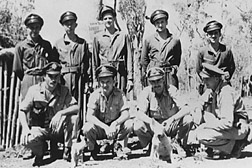
The Shady Lady crew.
The plane lands on the desolate Anjo Peninsula, the northwest part of Napier-Broome Bay in the Kimberly region, about 60 miles northwest of the Royal Australian Air Force landing strip at Drysdale mission, near Kalumburu. They are about 312 miles southwest of their take-off point in Darwin.
- 1000-1800: Remained near plane. Tried to get radio contact using kite and portable transmitter. Find radio punctured by shell and useless. Finally got plane’s radio going and contacted Darwin. Ate K-Rations at noon.
Our water supply low. Flies are very thick and headnets are godsend. Late afternoon we sight Lockheed and send up a flare. They drop food but water containers split on landing. Signals indicate: “Rescue party will reach you tomorrow afternoon.”
- 1830: Doug [Craig, the pilot], Rusty, and I left for coast. It was a good hour and a half there and back through brush and marshes. When we reached the sea we had a nice wash in the salt water.
- 2000: Back to the plane. Turned in near the plane. Slept on jungle kits and parachutes. Sand fleas so bad that we all wore gloves and headnets to bed.
Aug. 15, 1943 (Sunday)
- 0800-1200: Arose and I had a bite to eat. Water is now rationed. Got on shady side of the plane and dozed.
- About 1030 a shout from one of the crew. Coming across the marsh were three blacks, one towering a good 6 feet, 5 inches. They were unarmed. Several of the crew went to meet them. Yelled out, “Ya, Ya” (“hail,” “hello”) and prepared to use sign language. No need, for the tall leader boomed forth a “good morning.” Come to find out they are Christian natives on holiday from the mission at Drysdale. They wore crucifixes and bore the Christian names of Paul, Johnny, and Boniface (latter did not speak any English). Their bodies were disfigured by welts and painted with ashes and clay (said they had been dancing all night). We asked where we could get water. Paul pointed southeast and said it was “just a little way.” Craig, Rustin and Jackson [co-pilot] took all our canteens and left with the Aborigines for water. “Just a little way” proved to be over six miles, for they were gone over two hours. The Aborigines dug into a dry creek bed to find the water and built a fire so the place could be found again should it be necessary. Back at the plane site the rest of us took a dip in one foot of salt water that began to flow into the marsh a few hundred feet from the plane.
- 1300-1930: Lunch of canned rations and a small cup of brackish water apiece. The Aborigines sat cross-legged and ate the candy we had given them. Later in the afternoon a native, about 18, joined us. He carried two spears, a thrower and a hatchet. He was persuaded to give us an exhibition. By means of his thrower, a three-foot rod with a knob on one end a hook on the other, he could propel his spears swiftly and accurately.
- In mid-afternoon the Lockheed again flew over and tried unsuccessfully to drop water. Got more food OK. Flashed message: “Lugger will arrive by dusk, light fires.” A wood detail starts out and spirits rise. Lockheed spends most of afternoon flying bearings from ship-to-shore positions.
- About 1730 several of the crew went with our three Aboriginal friends to the probable anchorage of the lugger. We almost pass our rescuers coming in but the Aborigines hear them and flares attract the party.
- 1930-2300: Rescue party of four Aussies, Father Seraphim Sanz of Drysdale mission, and about five natives arrive with food and water. We all sit around the fire and fill up on canned meats, real bread and jam, hot tea and water. Due to low tides the decision was made not to head out till morning. Hit the hay about 2300.
Aug. 16, 1943 (Monday)
- 0300: The tide came up and the cold and flies woke me. Found Father Seraphim and several others also awake. We spent some time talking about the mission, language, and customs of Aborigines.
- 0300: The Father himself spoke their language. He finally got the natives to sing for us. They had been reluctant due to a seven-eighths eclipse of the moon occurring. We built them a small fire and gave them a large tin can and empty flare cylinder to use for drumming. Their music was within a five-tone range and was sung somewhat like our rounds.
- 0400: Began our safari to the coast. Each of us carried his own personal belongings. The “boys” carried the rest of the special equipment. For over an hour our guides picked their way through untrailed wilderness until we reached the coast about daybreak. Here the entire party was transferred to the lugger, which had been pulled to within a quarter of a mile of shore.
- 0830-1400: The day was sunny and the sun beat down on the deck. The native pilot picked his way slowly through the many reefs and shoals which abounded. We had a lunch of hot tea and bread and jam sandwiches.
Afterwards two Aussie noncomms got out their rifles and shot at fish, crocodiles, and tin-can targets. Saw a huge sail fish jump clean out of the water. Finally the lugger arrived off coast near the old mission. Was shuttled ashore in choppy seas. We all got soaked.
The lugger had crossed Napier-Broome Bay to land on its east side, at the original site of the Drysdale mission, founded in 1908 by the Benedictines order. In the 1930s, the mission moved further south to near Kalumburu on the King Edward River, where the RAAF built its Drysdale airfield, the strip Shady Lady had hoped to reach before its crash landing.
- 1400-1700: Were trucked to the old mission. Here we were welcomed by the commanding officer. First he took us to a pail shower operated by hand. Next we had set before us a feast fit for a king. With the nice hot meal went ice-cold punch and tomato juice. The camp photographer took some pictures of the crew, the natives, and our rescuers.
- 1700-2300: Left by truck for the new Drysdale mission. Arrived in time for supper. Here we met F/Lt. O’Neill and his crew of the rescue plane. We visited the mission buildings and met the priests headed by Father Thomas. Chatted with them about the mission and its work. Most of them are Spanish. One priest has been there for nearly 30 years. They only hope to keep the natives from killing each other. Can only Christianize and teach English to the young Aborigines. The Fathers showed us some native handicrafts. We purchased some arrows. Before we left, Father Thomas gave us some watermelon. What a treat. Then back to quarters.
Aug. 17, 1943 (Tuesday)
- 0700-1230: After an early breakfast, we piled aboard the Lockheed-Hudson with F/Lt. O’Neill and his crew for the 250-mile trip back to our home base at Fenton. As we neared the airfield, the gunners inserted their guns and test fired them. I wondered what was up. On gazing groundward, I saw the smoking ruins of a plane.
Believe it or not, had we arrived a few minutes sooner, we would have been in great danger. The Japanese had just carried out a bombing raid on Fenton Field. Actually the Jap bombers must have passed over us as we approached to land. And so ends the log of Shady Lady for she never flew in combat again.
Postscript
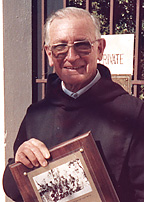
Father Seraphim Sanz, who helped lead the crew to the coast, holding a framed photo of the crew in 1988.
On Sept. 10, after being partially repaired and disarmed to lighten, Shady Lady is flown out of the marshes and back to Fenton, but the bomber never flies in combat again. The plane’s nose turret sits on the salt pan to this day, and tire marks from the landing are still visible.
At the end of the month, 21 Japanese aircraft bomb and strafe Drysdale airfield and the nearby mission. The attack destroys the mission building and kills five civilians, including Father Thomas, the priest who gave the Shady Lady crew a tour of the mission and the friendly gift of watermelon.
In 1988, as part of the country’s bicentennial, John Nash returns to Australia and reunites with Father Seraphim Sanz, the monk (he recently turned 90) who helped bring the Shady Lady crew to the coast.
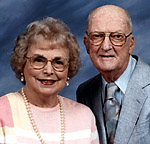
John and Lauraine Nash.
Today, Nash, who taught high school on Long Island for many years, and his Australian-born wife, Lauraine (they met when her father invited the Shady Lady crew to a neighborhood party), live in Palm Harbor, Fla.
Photos: the Shady Lady salvage operation
The following photos of the Shady Lady salvage operation were taken by the late Eugene Halaas, Pacific theater photographer during World War II. Below, crew and aborigines pose in front of the plane, with its nose dug into the salt pan, before salvage operations.
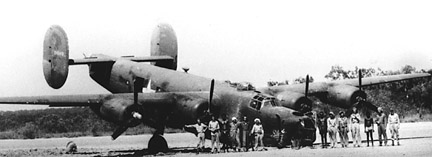
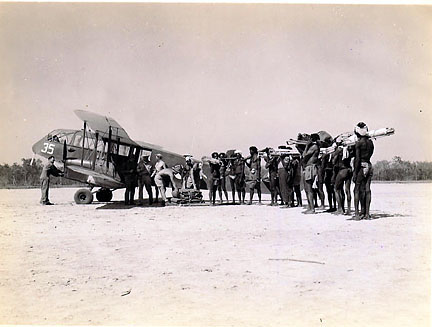
Above, military personnel and aborigine helpers unload a rescue plane carrying supplies to repair Shady Lady. Below, extra weight is removed from the bomber.
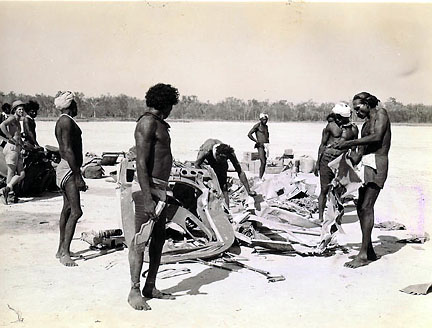
At work during salvage operations:
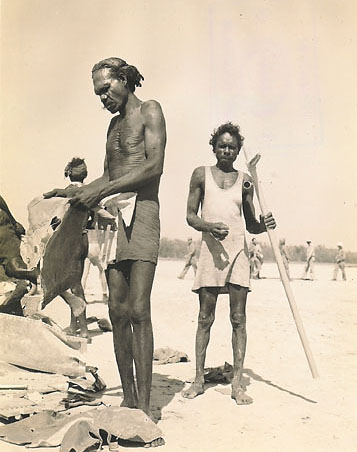
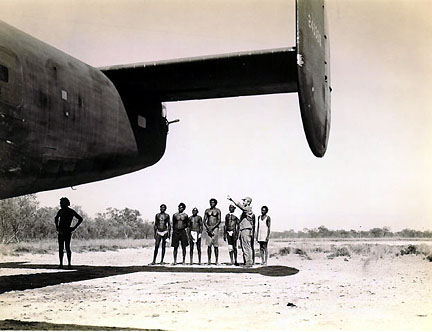
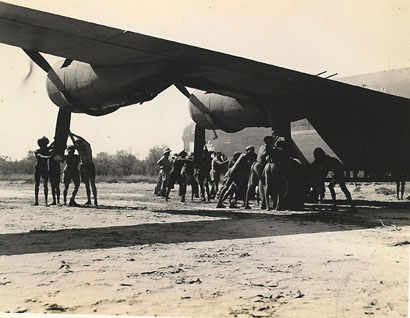
Shady Lady is pushed into position to fly from the salt pan on Sept. 10, 1943. Subsequently, an illustrated rendering of the Shady Lady salvage operation, based on these photographs, was published in Yank magazine of December 1943.
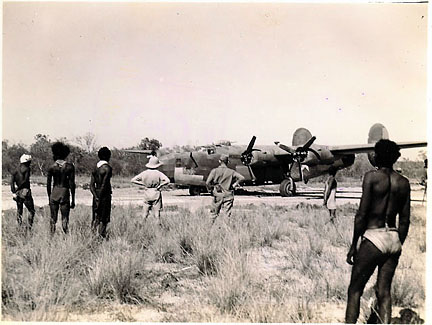
Repairs completed, Shady Lady starts engines and prepares to fly from the salt pan.
Appreciation: To David Halaas for providing these photographs taken by his grandfather, the late Eugene Halaas; to aviation historian Lindsay Peet of Western Australia; and to Peter Dunn, whose Web site, Australia @ War, provides extensive information on wartime Australia, including a page on the Shady Lady.